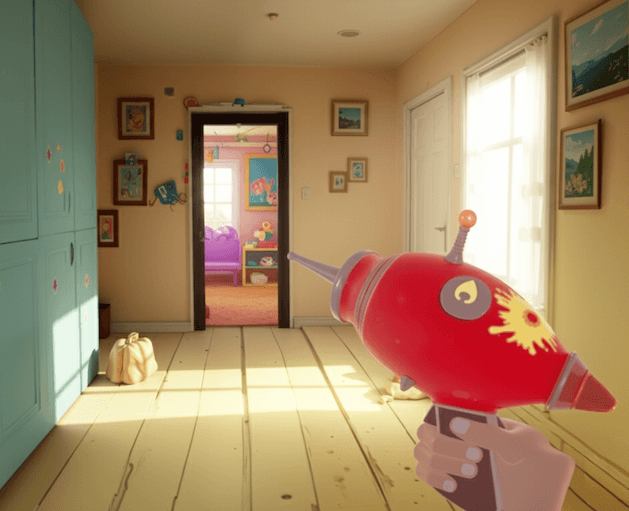Nov 12, 2025How Marble’s world models and World Labs’ spatial tools transformed one image into a 30-room interactive memory space.
From Stillness to Space: Turning a Single Image into a Living World
Overview
Artist and filmmaker Wilfred Lee (Artist’s Journey) set out to explore a question that sits between technology and emotion: What does it mean to explore a house built from memory?
Using Marble to generate 3D scenes, then stitching them together and adding spatial audio, he created Memory House — an experimental narrative environment that begins as a single 2D image and expands into an explorable multi-room world.
Built entirely from AI-generated imagery and sound, Memory House blends Gaussian splatting, generative narration, and audio to craft a meditative experience about perception, stillness, and the spaces we imagine when we remember.
The result is part dream, part architecture — a living world that feels remembered rather than rendered.
Reimagining the Creative Process
Wilfred began with a series of still domestic scenes — a bedroom, a kitchen, a hallway — rendered in Marble from hand-curated 2D images.
These static moments became portals, each one reconstructed into a walkable room filled with depth, light, and tone.
From there, the project expanded into liminal corridors and surreal observatories, transforming familiar spaces into subconscious landscapes.
“Each room was like walking through a thought. Marble gave me a way to translate that — to move through memory instead of just depicting it.”
Wilfred Lee
To guide iteration, he built World Builder Companion, a custom GPT-powered tool that analyzed each generated scene and adjusted Marble prompts for lighting, geometry, and atmosphere.
Working alongside Marble’s spatial generation, this assistant helped refine tone and composition, allowing Wilfred to maintain narrative coherence across dozens of connected environments.
Experience Memory House
Technical Workflow
The Memory House pipeline combined world reconstruction, spatial stitching, and adaptive audio in a modular loop:
- Image to World: Each 2D prompt was processed through Marble for Gaussian splat reconstruction, transforming still imagery into immersive 3D space.
- Composer Integration: Generated rooms were stitched and aligned within Marble’s Composer.
- Spark Integration: The world was deployed with Spark for the ability to traverse the world.
- Cinematic Memory Sequences: Using Veo3 for visual transitions and ElevenLabs for adaptive voice cues, Wilfred wove dynamic sound and narrative beats that evolved with player proximity.
- Optimization: Large worlds were decomposed into modular stitched segments for real-time performance, balancing fidelity with the ability to explore.
A key innovation was prompt optimization through World Builder Companion, which learned to interpret Marble’s depth and lighting behavior — tuning prompt phrasing to achieve consistent visual results.
This loop allowed for iterative worldbuilding without manual modeling or heavy photogrammetry, introducing a new workflow for independent artists exploring spatial storytelling.
Creative Outcomes
Memory House shows how Marble’s spatial generation can serve as both an artistic and emotional instrument.
Within hours, Wilfred was able to turn still photographs into narratively coherent 3D spaces, blending proximity-based sound design and environmental composition to evoke the feeling of exploring a fading memory.
The project proved that AI-assisted worldbuilding can carry narrative and mood — not just structure.
By merging Marble’s visual intelligence with World Labs’ audio and interaction systems, Memory House became a prototype for a new kind of immersive, memory-driven storytelling — where every corridor and sound evokes something half-remembered.
For artists and studios, the project also established a repeatable pipeline:
- Generate world geometry with Marble
- Stitch environments using the composer tool in Marble Studio
- Integrate interactives and cinematic experience through Spark
Looking Ahead
Wilfred’s next steps extend Memory House beyond the screen. Upcoming experiments include:
- Adaptive AI dialogue powered by GPT-5 multimodal prompts and ElevenLabs voice synthesis
- Procedural soundscapes that evolve with player movement and emotional tone
- Collaborative worldbuilding, where multiple artists generate connected Marble environments simultaneously
He is also exploring live editing inside Marble, including finer control over image-to-depth reconstruction, Gaussian brush editing, and in-tool ambient audio layering.
“Every image is a world waiting to be entered. Marble lets me open the door.”
Wilfred Lee
Memory House stands as a quiet example of how imagination and technology can work together to create something deeply personal.
Read More
Sep 16, 2025
Gaussian Mansion: Creating Playable Worlds with Marble
Integrating spatial generation, AI-driven modeling, and Unreal Engine to streamline 3D world production from concept art to gameplay.

Sep 16, 2025
Splat World: Exploring New Dimensions of Gaussian Splatting in VR
How one developer turned Gaussian splats into a new language for building interactive worlds.
